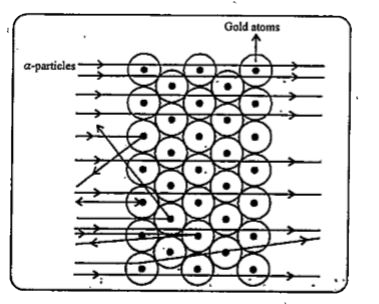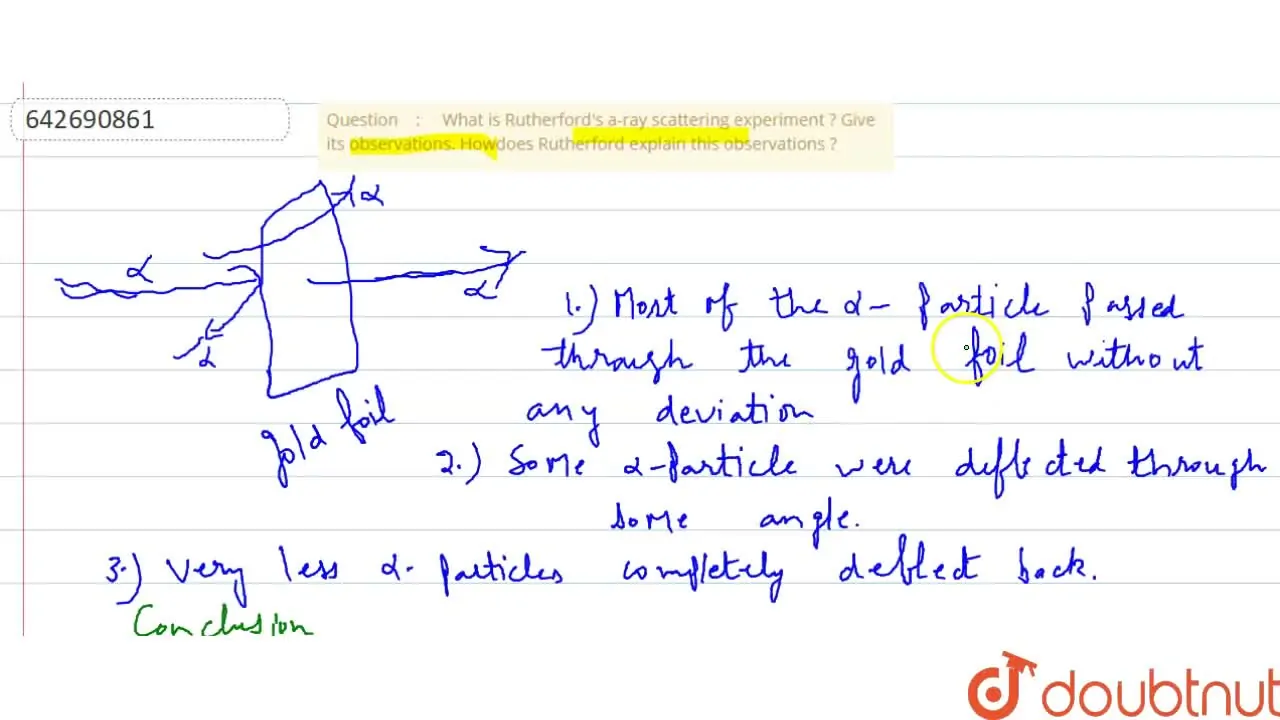What is Rutherford's a-ray scattering experiment ? Give its observations. Howdoes Rutherford explain this observations ? Solution in Punjabi
Rutherford.s α-scattering experiment. Ernest Rutherford was interested in knowing how the electrons are arranged within an atom.
Rutherford designed an experiment for this. In this experiment, fast moving alpha (α)-particles were made to fall on a thin gold foil.
(i) He selected a gold foil because he wanted as thin a layer as possible. This gold foil was about 1000 atoms thick.
(ii) α-particles are doubly-charged helium ions. Since they have a mass of 4u, the fast-moving α-particles have a considerable amount of energy.
(iii) It was expected that α-particles would be deflected by the sub-atomic particles in the gold atoms. Since the α-particles were much heavier than the protons. He did not expect to see large deflections.

But, the α-particle scattering experiment gave totally unexpected results. The following observations were made :
(i) Most of the fast moving α-particles passed straight through the gold fall.
(ii) Some of the α-particles were deflected by the foil by small angles.
(iii) Surprisingly one out of every 12000 particles appeared to rebound.
In the words of Rutherford, "This result was almost as incredible as if you fire a 15-inch shell at a piece of tissue paper and it comes back and hits you".
Rutherford concluded from the α-particle scattering experiment that
(i) Most of the space inside the atom is empty because most of the α-particles passed through the gold foil without getting deflected.
(ii) very few particles were deflected from their path, indicating that the positive charge of the atom occupies very little space.
(iii) A very small fraction of α-particles were deflected by 180∘, indicating that all the positive charge and mass of the gold atom were concentrated in a very small volume within the atom.
From the data he also calculated that the radius of the nucleus is about 105 times less than the radius of the atom.
On the basis of his experiment, Rutherford put forward the nuclear model of an atom, which had the following features :
(i) There is a positively charged centre in an atom called the nucleus. Nearly all the mass of an atom resides in the nucleus.
(ii) The electrons revolve around the nucleus in well-defined orbits.
(iii) The size of the nucleus is very small as compared to the size of the atom.
Related Playlists
Similar Questions
Compare the properties of electron, proton and neutron
View SolutionName the three states of matter.
01:24View SolutionWhat are the observations of α-ray scattering experiment ? Based on thse obervations , how did Rutherford disprove Thomson's model ?
11:29View SolutionIn Rutherford's experiment , scattering of more than 1∘ was observed in
02:36View Solutionरदरफोर्ड के α - प्रकीर्णन प्रयोग की सचित्र व्याख्या कीजिए । रदरफोर्ड के अवलोकन को दीजिए तथा प्रयोग के महत्व को समझाइए ।
11:58View SolutionWhich of the following observations was not correct during Rutherford's scattering experiment?
View SolutionDescribe Rutherford's alpha -ray scattering experimental and mention the observations derived from it. Cite and defect of Rutherford's model of the atom.
09:22View SolutionAfter the execution of the alpha-ray scattering experiment what were the observatoins made by Rutherford? What did he conclude from his observation?
02:59View SolutionWhat is Rutherford's a-ray scattering experiment ? Give its observations. Howdoes Rutherford explain this observations ?
04:13View SolutionWhich of the following observations was not correct during Rutherford's scattering experiment?
08:05View Solutionरदरफोर्ड के प्रकीर्णन प्रयोग के दौरान निम्न में से कौन-सा निरिक्षण सही नहीं था?
02:14View SolutionExplain the experiment done by Rutherford and give its observations.
02:45View SolutionBased on his alpha -ray scattering experiment, Rutherford proposed the nuclear model of an atom. a) Give the main postulates of Rutherford's atom model.
02:14View SolutionThe results fo Rutherford's alpha -ray scattering experiment were quite unexpected. a) Write the observation of Rutherford's alpha -ray scattering experiment which leads to the conclusion that most of the space in an atom is empty.
02:38View SolutionBased on alpha ray scattering experiment Rutherford proposed the nuclear model of atom.Give the main postulates of rutherford's nuclear model of an atom.
01:07:30View Solutionयदि रदरफोर्ड अपने प्रयोग में β- किरणों का प्रयोग करते तो उनका प्रेक्षण क्या होता?
02:13View Solution


